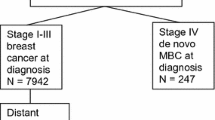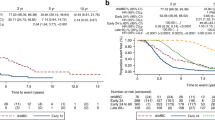Abstract
Approximately 6 % of patients with breast cancer are diagnosed with de-novo distant metastases. We set out to look at two cohorts of patients seen at breast cancer-specific practices, compare the results to other reports and larger databases, and see how advances in treatment have impacted overall survival (OS). The records from a large breast cancer oncology private practice and a second data set from the University of Miami/Sylvester Comprehensive Cancer Center (UM/SCCC) tumor database were, retrospectively, reviewed to identify patients with de-novo metastases. We included those patients identified to have metastatic disease within 3 months of diagnosis of a breast primary cancer. Patients diagnosed between 1996 and 2006 were chosen for our study population. The OS for the private practice was 41.0 months (46.0 for ER positive and 26.0 for ER negative) and 36.0 months for UM/SCCC (52 months for ER positive and 36 months for ER negative). ER negativity and CNS- or visceral-dominant disease were associated with a significantly worse prognosis within the private practice. Dominant site was associated with a significantly worse prognosis within the UM/SCCC database but with a trend also for ER negativity. Age and ethnicity did not contribute significantly to the survival of patients within either cohort. The median survival in both cohorts and most other reported series was larger than that seen in the surveillance, epidemiology, and end results program and the National Cancer Database. The median OS among patients with de-novo metastatic breast cancer treated within two breast-specific oncology practices was over 3 years, which appears better than larger, more inclusive databases and publications from earlier decades.

Similar content being viewed by others
References
Howlader N, Noone AM, Krapcho M et al (2013) SEER Cancer Statistics Review, 1975-2010, National Cancer Institute, Bethesda. http://seer.cancer.gov/csr/1975_2010/. Based on November 2012 SEER data submission, posted to the SEER web site
Dawood S, Broglio K, Ensor J et al (2010) Survival differences among women with de novo stage IV and relapsed breast cancer. Ann Oncol 21(11):2169–2174. doi:10.1093/annonc/mdq220
Lobbezoo DJA, van Kampen RJW, Voogd AC et al (2015) Prognosis of metastatic breast cancer: are there differences between patients with de novo and recurrent metastatic breast cancer? Br J Cancer 112(9):1445–1451. doi:10.1038/bjc.2015.127
Rahman Z, Frye D, Smith T (2000) Results and long term follow-up for 1581 patients with metastatic breast carcinoma treated with standard dose doxorubicin containing chemotherapy. Cancer 40(19990101):1–2
Nieto Y, Nawaz S, Jones RB et al (2002) Prognostic model for relapse after high-dose chemotherapy with autologous stem-cell transplantation for stage IV oligometastatic breast cancer. J Clin Oncol 20(3):707–718
Dawood S, Broglio K, Gonzalez-Angulo AM et al (2008) Trends in survival over the past two decades among white and black patients with newly diagnosed stage IV breast cancer. J Clin Oncol 26(30):4891–4898. doi:10.1200/JCO.2007.14.1168
Hortobagyi GN (2002) Can we cure limited metastatic breast cancer? J Clin Oncol 20(3):620–623
Andre F, Slimane K, Bachelot T et al (2004) Breast cancer with synchronous metastases: trends in survival during a 14-year period. J Clin Oncol 22(16):3302–3308. doi:10.1200/JCO.2004.08.095
Güth U, Magaton I, Huang DJ, Fisher R, Schötzau A, Vetter M (2014) Primary and secondary distant metastatic breast cancer: two sides of the same coin. Breast 23(1):26–32. doi:10.1016/j.breast.2013.10.007
Friedel G, Pastorino U, Ginsberg RJ et al (2002) Results of lung metastasectomy from breast cancer: prognostic criteria on the basis of 467 cases of the international registry of lung metastases. Eur J Cardio-thorac Surg 22(3):335–344
Chia SK, Speers CH, D’yachkova Y et al (2007) The impact of new chemotherapeutic and hormone agents on survival in a population-based cohort of women with metastatic breast cancer. Cancer 110(5):973–979. doi:10.1002/cncr.22867
Zinser JW, Hortobagyi GN, Buzdar AU, Smith TL, Fraschini G (1987) Clinical course of breast cancer patients with liver metastases. J Clin Oncol 5(5):773–782
Sledge GW, Neuberg D, Bernardo P et al (2003) Phase III trial of doxorubicin, paclitaxel, and the combination of doxorubicin and paclitaxel as frontline chemotherapy for metastatic breast cancer: an intergroup trial (E1193). J Clin Oncol 21:588–592
Brufman G, Colajori E, Ghilezan N et al (1997) Doubling epirubicin dose intensity (100 mg/m2 versus 50 mg/m2) in the FEC regimen significantly increases response rates. An international randomised phase III study in metastatic breast cancer. The epirubicin high dose (HEPI 010) study group. Ann Oncol 8(2):155–162
Slamon DJ, Leyland-Jones B, Shak S et al (2001) Use of chemotherapy plus a monoclonal antibody against HER2 for metastatic breast cancer that overexpresses HER2. N Engl J Med 344:783–792
Aisner J, Cirrincione C, Perloff M et al (1995) Combination chemotherapy for metastatic or recurrent carcinoma of the breast—a randomized phase III trial comparing CAF versus VATH versus VATH alternating with CMFVP: Cancer and Leukemia Group B Study 8281. J Clin Oncol 13(6):1443–1452
Estaban E, Lacave AJ, Fernández JL et al (1999) Phase III trial of cyclophosphamide, epirubicin, fluorouracil (CEF) versus cyclophosphamide, mitoxantrone, fluorouracil (CNF) in women with metastatic breast cancer. Breast Cancer Res Treat 58(2):141–150
Pacini P, Rinaldini M, Algeri R et al (2000) FEC (5-fluorouracil, epidoxorubicin and cyclophosphamide) versus EM (epidoxorubicin and mitomycin-C) with or without lonidamine as first-line treatment for advanced breast cancer. A multicentric randomised study. Final results. Eur J Cancer 36(8):966–975
Lee T, Isaacs C (2014) Treatment of primary breast tumors in de novo metastatic breast cancer. Clin Adv Hematol Oncol 12(12):820–827
Dominici L, Najita J, Hughes M et al (2011) Surgery of the primary tumor does not improve survival in stage IV breast cancer. Breast Cancer Res Treat 129(2):459–465
Rapiti E, Verkooijen HM, Vlastos G et al (2006) Complete excision of primary breast tumor improves survival of patients with metastatic breast cancer at diagnosis. J Clin Oncol 24(18):2743–2749
Shien T, Nakamura K, Shibata T et al (2012) A randomized controlled trial comparing primary tumour resection plus systemic therapy with systemic therapy alone in metastatic breast cancer (PRIM-BC): Japan Clinical Oncology Group Study JCOG1017. Jpn J Clin Oncol 42(10):970–973
Babiera GV, Rao R, Feng L et al (2006) Effect of primary tumor extirpation in breast cancer patients who present with stage IV disease and an intact primary tumor. Ann Surg Oncol 13(6):776–782
Infante JR, Yardley DA, Burris HA 3rd et al (2009) Phase II trial of weekly docetaxel, vinorelbine, and trastuzumab in the first-line treatment of patients with HER2-positive metastatic breast cancer. Clin Breast Cancer 9(1):23–28
Berghoff AS, Bago-Horvath Z, Dubsky P et al (2013) Impact of HER-2-targeted therapy on overall survival in patients with HER-2 positive metastatic breast cancer. Breast J 19(2):149–155. doi:10.1111/tbj.12070
Gennari A, Amadori D, De Lena M et al (2006) Lack of benefit of maintenance paclitaxel in first-line chemotherapy in metastatic breast cancer. J Clin Oncol 24(24):3912–3918
Bertaut A, Mounier M, Desmoulins I et al (2015) Stage IV breast cancer: a population-based study about prognostic factors according to HER2 and HR status. Eur J Cancer Care (Engl). doi:10.1111/ecc.12306
Rossi V, Nolè F, Redana S et al (2014) Clinical outcome in women with HER2-positive de novo or recurring stage IV breast cancer receiving trastuzumab-based therapy. Breast 23(1):44–49. doi:10.1016/j.breast.2013.10.005
Vaz-Luis I, Lin NU, Keating NL et al (2015) Racial differences in outcomes for patients with metastatic breast cancer by disease subtype. Breast Cancer Res Treat 151(3):697–707. doi:10.1007/s10549-015-3432-1
Yardley DA, Kaufman PA, Brufsky A et al (2014) Treatment patterns and clinical outcomes for patients with de novo versus recurrent HER2-positive metastatic breast cancer. Breast Cancer Res Treat 145(3):725–734. doi:10.1007/s10549-014-2916-8
National Cancer Data Base. American College of Surgeons. https://www.facs.org/quality-programs/cancer/ncdb. Accessed August 1st, 2014
Zeichner SB, Ambros T, Zaravinos J et al (2015) Defining the survival benchmark for breast cancer patients with systemic relapse. Breast Cancer (Auckl) 9:9–17
Parise CA, Bauer KR, Brown MM, Caggiano V (2009) Breast cancer subtypes as defined by the estrogen receptor (ER), progesterone receptor (PR), and the human epidermal growth factor receptor 2 (HER2) among women with invasive breast cancer in California, 1999-2004. Breast J 15(6):593–602. doi:10.1111/j.1524-4741.2009.00822.x
Carey LA, Perou CM, Livasy CA et al (2006) Race, breast cancer subtypes, and survival in the Carolina Breast Cancer Study. JAMA 295(21):2492–2502. doi:10.1001/jama.295.21.2492
Cancer Rates by Race/Ethnicity and Sex. Division of Cancer Prevention and Control. Centers for Disease Control and Prevention. http://www.cdc.gov/cancer/dcpc/data/race.htm. Accessed Aug 5, 2015
Author information
Authors and Affiliations
Corresponding author
Ethics declarations
Conflict of interest
The authors declare there is no conflict of interest in the writing, preparing, or finalizing of this manuscript.
Rights and permissions
About this article
Cite this article
Zeichner, S.B., Herna, S., Mani, A. et al. Survival of patients with de-novo metastatic breast cancer: analysis of data from a large breast cancer-specific private practice, a university-based cancer center and review of the literature. Breast Cancer Res Treat 153, 617–624 (2015). https://doi.org/10.1007/s10549-015-3564-3
Received:
Accepted:
Published:
Issue Date:
DOI: https://doi.org/10.1007/s10549-015-3564-3




